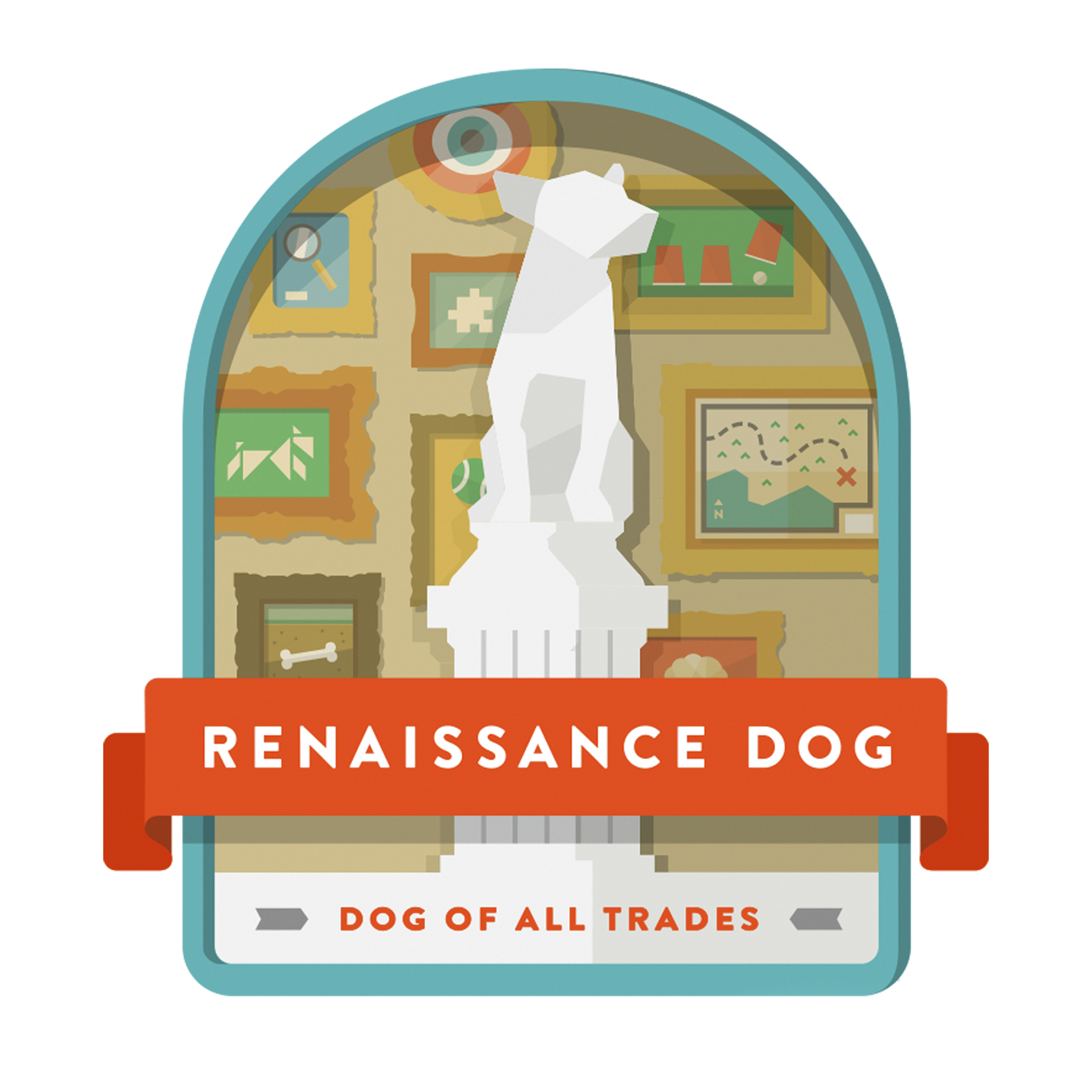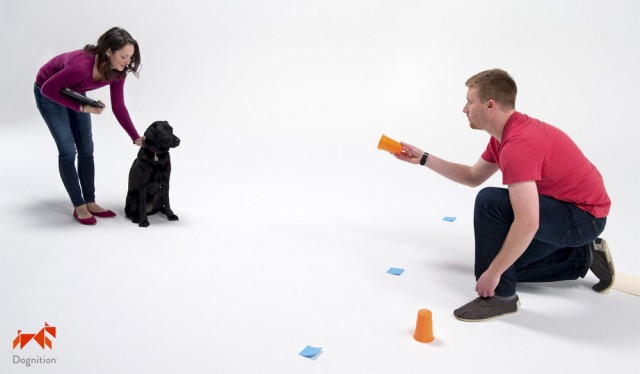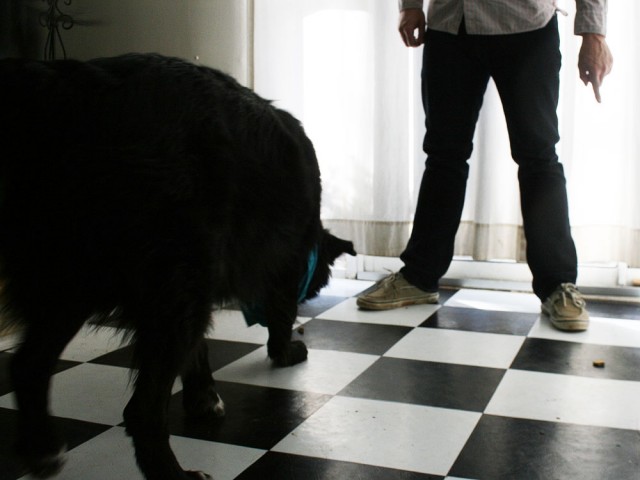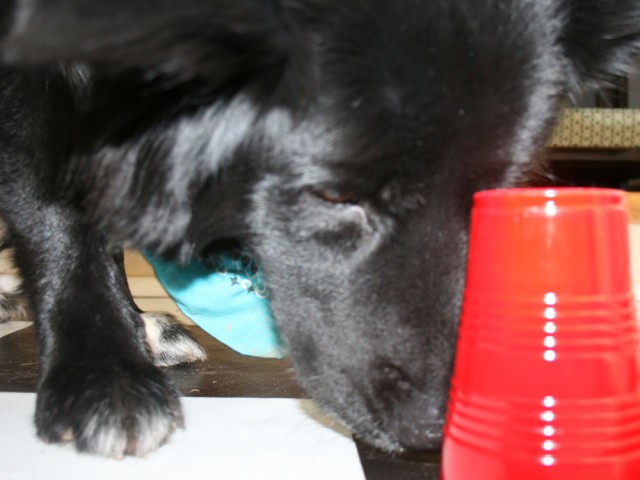Dognition is a new experience to share with your dog, built on years of research and cutting-edge technology. The main component of Dognition is the science-based games, but there’s so much more to it. By participating in Dognition, you’ll uncover the unique way your furry friend sees the world and, in doing so, nurture and enrich your relationship.
But what does that mean? Here’s how it went for me and my dog, Teddy.
The first thing I did after activating my Dognition account was set up a profile for Teddy. I answered a few easy questions about his size, age and breed. My wife and I think that Teddy’s a mix of at least four different breeds, so fortunately there was a “mixed breed” option to choose. This information helps personalize the Dognition Experience. So, from here on out, I wasn’t reading about “your dog,” but about “Teddy.” And “your dog” wasn’t playing the games, Teddy was.
The other reason Dognition asks about your dog’s size, breed and age is so that, when enough dogs have played the games, we may be able to make new discoveries about dogs who share similarities with yours. Maybe one day we will know which breed is scientifically the most cunning. Is the Foxhound as sly as a fox?
Personality Questionnaire
In order to get a complete picture of your dog’s unique cognitive style, Dognition needs to know about some things you’ve observed about your dog that a game may not be able to take into account. For instance, is your dog easily startled? We wouldn’t ask you to play a game in which you sneak up on your dog and shout, so this is the kind of thing that’s better for you to speak to based on your experience.
I enjoyed this part of Dognition almost as much as I did playing the games with Teddy. As much as I love to be with my fuzzy-faced pal, I also like to sit back and reflect on my relationship with him from time to time. I started the questionnaire from my desk at work, but decided to finish it at home, where my wife could help me confirm or deny some of the notions I had about Teddy. Once we finished the personality questionnaire, it was on to the games!
Playing the Games in the Toolkit
This is perhaps the most exciting section of the Dognition Experience. For years, scientists like Brian Hare have been developing ways to evaluate how all dogs think. Today, thanks to the work of Brian and his colleagues on the Scientific Advisory Board, we can offer you similar games to play with your dog in the comfort of your own home.
You may have seen the sample game clip on our site or Facebook page. The Arm Pointing game is a real activity from Dognition, designed to help you understand how closely your dog relies on your gestures to solve problems.
The Arm Pointing Game is just one of 12 science-based games, split into five sets. You may choose to spread them out over as many days as you like, but most people complete them in two to three days. The first three sets of games are shorter than the last two, so my wife, Teddy and I played the Empathy, Communication and Cunning games in one night. Then we played the Memory and Reasoning games over the course of the next two nights.
Part of what makes the games section so great is that you can play at home with things you probably already have around the house. But for me, the most biggest reward was watching Teddy as we played, seeing the little gears turn in his head as he played and solved problems. More than a few times, I found my wife and I looking up at each other, nodding in amazement as Teddy surprised us with the strategies he used.
The Dognition Profile Report
This is what it all comes down to. You’ve completed out the personality questionnaire, you spent time bonding with your dog over science-based games, and now it’s time to discover what’s unique about your dog.
Within moments of completing the last game, Dognition provides you with a colorful 12-15-page readout on your dog. The first thing you’ll see in this colorful, comprehensive report is a badge with the name of your pet’s Dognition Profile. There are nine profiles in total, derived from a matrix of the two key canine cognitive dimensions: social problem solving and independent problem solving. Each profile represents a different combination of cognitive skills and strategies. Teddy’s a Renaissance Dog, which mean that rather than being a specialist, he is good at a little bit of everything.
Each game is recapped, along with the meaning of the choices your dog made while playing. You’ll see how your dog’s cognitive style compares to other members of the animal kingdom. Did you know that ravens are excellent problem solvers? How raven-like is your dog?
I was surprised to learn how wily Teddy is, and that he doesn’t always rely on collaborative strategies to solve problems. Reading this, I suddenly remembered all of the times I stood on the back porch, calling him in from the cold, while he just lay there with his ball between his paws. It wasn’t that he didn’t understand me — he was just using his intelligence to get what he wanted, which was for me to grab the ball and give it another throw.
So, now that I understand him better, I can start working with him in ways I hadn’t tried before. We’re planning on signing up for training classes, and I’m going to share Teddy’s report with the trainer I choose so that he or she can use Teddy’s unique intelligence to help him learn more efficiently and effectively.
Continued Enrichment
In addition to the Toolkit, Dognition offers a membership package to help you continue to nurture your dog and enrich your relationship. You’ll get a new science-based game to play every month. These games are used together with your Dognition Profile to paint an even richer picture of your dog’s cognitive strategies.
Along with the new games, you’ll get tools and tips from expert trainers, based on your dog’s cognitive style. Dognition can even connect you with trainers and behavior experts to help your dog continue to thrive in the future.
See what other dog lovers have said about Dognition in our previous blog post. If you have any questions about Dognition, feel free to send an email to hello@dognition.com, or contact us via Twitter or Facebook. And of, course, we love to see photos of your dogs! Woof!






Pam Hurley (with my German Shorthaired Pointer, Deke)
Reading about Teddy holding out for one more throw keyed a memory of Pepper at the dog park. We lived in an area with a private dog park and his favorite occupation is chasing and retrieving a thrown ball. Late in the afternoon we had been playing for about 45 minutes and it was time to go home for dinner. i told him “OK – this is the last one” just before i threw the ball. He ran, fetched and brought the ball straight back – to one of the women there with her dog. Surprised and unthinking, she threw the ball for Pepper. And he promptly brought it back to her. The third time he brought it back she asked me “Why is he bringing this to me? He never brings me the ball.” Pepper had gotten his three more throws by using his smarts. I told him “last one” and he wasn’t ready to quit.
@PeppersPop Sounds like Pepper’s a cunning fella!
Dognition PeppersPop Interesting follow up note. We recently moved from our house to an apartment on a temporary basis. As a result we walk Pepper to do his business instead of just letting him outside in the back yard. I taught him he was to sit when he finished his business while I cleaned up. After the second time he automatically started sitting when done.
Here is the interesting part – We were walking the other day and he had peed a couple of times. It was chilly and I was ready to return to the apartment. So I said – Go on, go poop! a couple of times. He looked at me for a few seconds, then sat down to tell me he didn’t need to go. Since then he has exhibited the same behavior on several occasions and even did so once when my wife was walking him.
It would be interesting to know at what age a human child starts to make inferences like that.